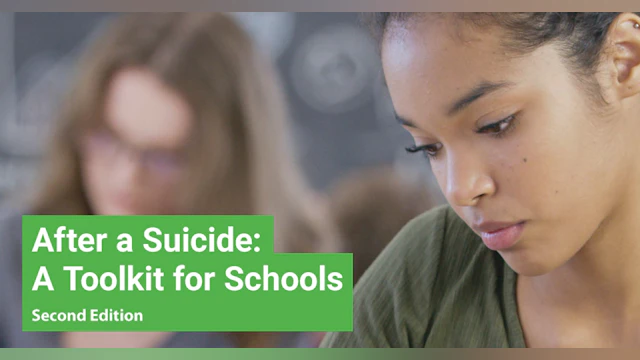Contacts: Alexis O’Brien, American Foundation for Suicide Prevention, 347-826-3577, aobrien@afsp.org
Jesse Gass, Suicide Prevention Resource Center, 617-618-2457, jgass@edc.org
Nation’s Top Suicide Prevention Organizations Partner to Release New Critical Resource for Schools
The American Foundation for Suicide Prevention and the Suicide Prevention Resource Center Release Second Edition of After a Suicide: Toolkit for Schools
NEW YORK (April 17, 2018) – Although youth suicide prevention efforts have increased in schools over the past decade, suicide is a leading cause of death among young people. In 2011, the American Foundation for Suicide Prevention (AFSP) and the Suicide Prevention Resource Center (SPRC) collaborated to create a resource providing middle and high schools with guidance on how to support school communities after a suicide occurs. Today, these organizations have released a newly updated second edition of this free resource, After a Suicide: A Toolkit for Schools.
The updated toolkit includes best practices for how school administrators and staff should respond to a suicide death, with information on helping students cope, reaching out to parents, and working with the community—including coroners, police departments, funeral directors, faith leaders, and mental health professionals. It provides tips on working with the media, tools for deciding how to safely memorialize students, and sample social media messages. Also included is important information on how to reduce the risk of suicide contagion (i.e., when exposure to a suicide death may influence others to attempt suicide).
“It is critically important that schools have a plan for responding in the tragic event that a student ends his or her own life. Schools will need to communicate effectively, quickly and in accordance with best practices, while at the same time, supporting grieving students and faculty,” said Dr. Doreen Marshall, AFSP Vice President of Programs. “The revised toolkit guides schools in the aftermath of suicide and can be used by schools to help them develop a response in advance of a suicide death. Written and reviewed by suicide prevention and school experts, it is a document that addresses many of the questions that schools have following a suicide death, while also giving them a framework through which to effectively respond. The last version of the toolkit released in 2011 is the premier resource schools turn to and we know this revision will be just as valuable.”
“The loss of a student to suicide is a traumatic event for the entire school community. After a Suicide: A Toolkit for Schools provides school administrators and staff with guidance for supporting those affected by the loss—including students, parents, teachers, and vulnerable members of the community,” said Elly Stout, director of SPRC, which is based at the nonprofit Education Development Center. By helping the school community cope with and process a suicide loss, the school can play a critical role in reducing suicide risk and preventing future tragedy.
The toolkit was developed primarily for administrators and staff in middle and high schools, but is also useful for parents and communities, and in some cases can be used in other educational settings. Developed by top suicide prevention experts and peer reviewed by academic and clinical professionals, After a Suicide: A Toolkit for Schools has been endorsed by the National Association of School Psychologists, the National Association of Secondary School Principals, and the American School Counselor Association. Here’s what they had to say:
National Association of School Psychologists: “After a Suicide: A Toolkit for Schools provides step-by-step guidance, templates, and resources all in one place. It is a vital resource to help school administrators and crisis teams plan for and implement appropriate postvention strategies to facilitate communications, support grieving students and staff, identify at-risk individuals, and more.”
National Association of Secondary School Principals: “Toolkits like After a Suicide: A Toolkit for Schools provide our members with tools and resources designed to help them work with faculty, staff, students, and others to restore the health of the school community. Resources like these are integral in helping principals and other school leaders carry out their mission to serve all students.”
American School Counselor Association: “After a Suicide: A Toolkit for Schools, developed by AFSP and SPRC, is a valuable guide to help school personnel prepare for the tumultuous and stressful aftermath of a student suicide and to help prevent future tragedies.”
This launch comes just prior to the American Association of Suicidology’s annual conference in Washington, D.C., in which AFSP and SPRC are both taking part.
This resource was made possible by funds raised at AFSP Out of the Darkness Community Walks held throughout the country, other AFSP fundraising events, and through SPRC’s grant from the U.S. Department of Health and Human Services (HHS), Substance Abuse and Mental Health Services Administration (SAMHSA), Center for Mental Health Services (CMHS).
About the American Foundation for Suicide Prevention
The American Foundation for Suicide Prevention is dedicated to saving lives and bringing hope to those affected by suicide. AFSP creates a culture that’s smart about mental health through education and community programs, develops suicide prevention through research and advocacy, and provides support for those affected by suicide. Led by CEO Robert Gebbia and headquartered in New York, AFSP has local chapters in all 50 states with programs and events nationwide. Learn more about AFSP in its latest Annual Report, and join the conversation on suicide prevention by following AFSP on Facebook, Twitter, Instagram, and YouTube.
About the Suicide Prevention Resource Center
The Suicide Prevention Resource Center (SPRC) is the nation’s only federally supported resource center devoted to advancing the National Strategy for Suicide Prevention. Based at the nonprofit Education Development Center, SPRC enhances the nation’s mental health infrastructure by providing states, government agencies, private organizations, colleges and universities, and suicide survivor and mental health consumer groups with access to the science and experience that can support their efforts to develop programs, implement interventions, and promote policies to prevent suicide. Follow SPRC on Facebook and Twitter.
# # #
